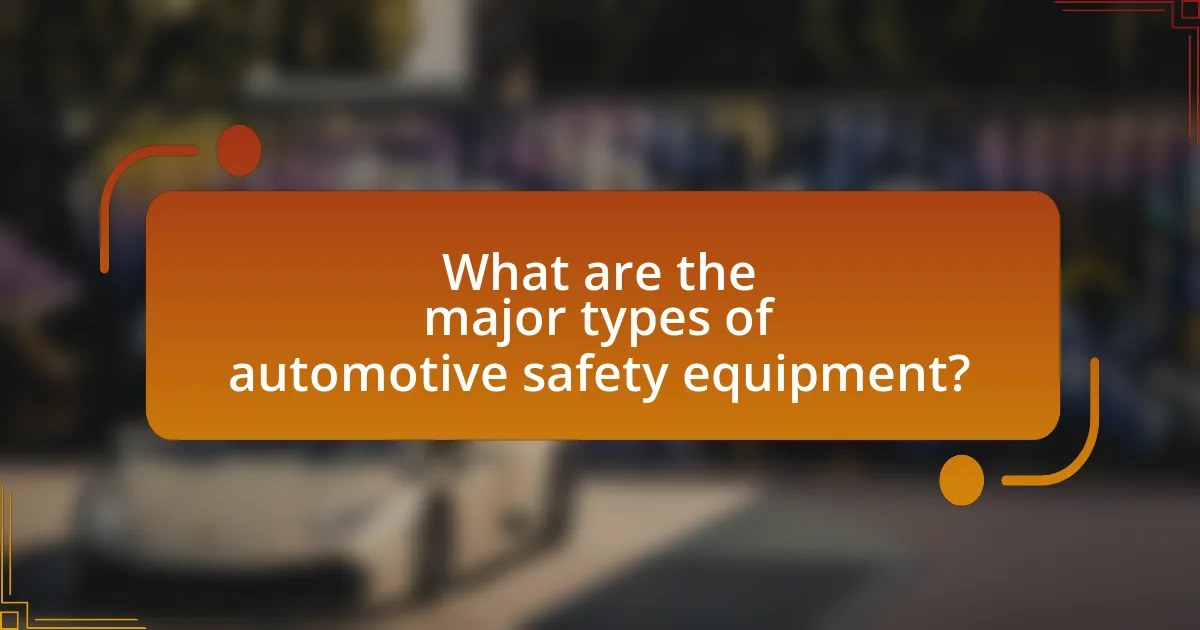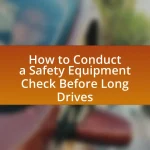The article focuses on the evolution of automotive safety equipment over the decades, highlighting significant advancements from the early 20th century to the present. It details key milestones such as the introduction of seat belts in the 1950s, airbags in the 1970s, and electronic stability control in the 1990s, which have collectively contributed to a marked reduction in road fatalities and injuries. The discussion includes the distinction between passive and active safety features, the impact of government regulations on safety standards, and the role of consumer demand in shaping safety technology. Additionally, it examines recent innovations like advanced driver-assistance systems and the influence of technology on safety equipment development.

What is the Evolution of Automotive Safety Equipment?
The evolution of automotive safety equipment has progressed significantly from the early 20th century to the present day. Initially, vehicles lacked basic safety features, with the first major advancement being the introduction of seat belts in the 1950s, which were designed to reduce injuries during collisions. In the 1960s, the National Highway Traffic Safety Administration (NHTSA) was established in the United States, leading to the implementation of safety standards and regulations.
By the 1970s, airbags began to emerge as a critical safety feature, providing additional protection in frontal crashes. The 1980s saw the introduction of anti-lock braking systems (ABS), which enhanced vehicle control during emergency braking situations. In the 1990s, advancements continued with the incorporation of electronic stability control (ESC) and side-impact airbags, further improving occupant protection.
The 2000s marked a shift towards active safety technologies, including lane departure warning systems and adaptive cruise control, which help prevent accidents before they occur. More recently, the development of advanced driver-assistance systems (ADAS) has revolutionized automotive safety, integrating features like automatic emergency braking and collision avoidance systems.
Overall, the evolution of automotive safety equipment reflects a continuous commitment to reducing fatalities and injuries on the road, supported by research and regulatory measures that have shaped the industry over decades.
How has automotive safety equipment changed over the decades?
Automotive safety equipment has significantly evolved over the decades, transitioning from basic features to advanced technologies aimed at enhancing occupant protection and accident prevention. In the 1960s, the introduction of seat belts became standard, which reduced fatalities by approximately 50% in frontal crashes. By the 1980s, airbags were introduced, providing additional cushioning during collisions, which further improved safety outcomes. The 1990s saw the implementation of anti-lock braking systems (ABS) and electronic stability control (ESC), which helped prevent loss of control during emergency maneuvers. In the 2000s and beyond, advancements included the integration of advanced driver-assistance systems (ADAS) such as lane departure warnings, adaptive cruise control, and automatic emergency braking, which have been shown to reduce crash rates by up to 40%. These developments reflect a continuous commitment to improving vehicle safety through technology and regulation.
What were the key milestones in automotive safety equipment development?
Key milestones in automotive safety equipment development include the introduction of seat belts in the 1950s, the implementation of airbags in the 1970s, and the establishment of electronic stability control in the 1990s. Seat belts were first made standard in vehicles, significantly reducing fatalities in accidents; studies show they can reduce the risk of death by 45%. Airbags became a critical safety feature, with the National Highway Traffic Safety Administration estimating that they saved over 50,000 lives between 1987 and 2017. Electronic stability control, mandated in the U.S. for all new vehicles in 2012, has been shown to reduce single-vehicle crashes by 49%. These milestones reflect significant advancements in automotive safety technology aimed at protecting occupants during collisions.
How did early safety features influence modern designs?
Early safety features, such as seat belts and crumple zones, significantly influenced modern automotive designs by establishing foundational principles of occupant protection and crashworthiness. The introduction of seat belts in the 1950s demonstrated a direct correlation between restraint systems and reduced fatalities, leading to mandatory regulations that shaped vehicle design to accommodate these features. Additionally, the implementation of crumple zones in the 1960s allowed vehicles to absorb impact energy, which informed the structural integrity of modern cars. These early innovations laid the groundwork for advanced safety technologies, such as airbags and electronic stability control, which are now standard in contemporary vehicles, reflecting a continuous evolution towards enhancing passenger safety.
Why is the evolution of automotive safety equipment important?
The evolution of automotive safety equipment is important because it significantly reduces the risk of injury and fatalities in vehicle accidents. Historical data shows that advancements such as seat belts, airbags, and electronic stability control have contributed to a decline in road fatalities; for instance, the National Highway Traffic Safety Administration reported that seat belts alone saved over 15,000 lives in 2017. Continuous improvements in safety technology, including collision avoidance systems and advanced driver-assistance systems, further enhance vehicle safety, demonstrating the critical role of innovation in protecting occupants and reducing the societal costs associated with traffic accidents.
What impact has automotive safety equipment had on accident survival rates?
Automotive safety equipment has significantly improved accident survival rates. Research indicates that the introduction of features such as airbags, seat belts, and electronic stability control has reduced fatalities and serious injuries in vehicle collisions. For instance, the National Highway Traffic Safety Administration (NHTSA) reported that seat belts alone saved approximately 15,000 lives in 2017. Additionally, the Insurance Institute for Highway Safety (IIHS) found that vehicles equipped with advanced safety technologies, like automatic emergency braking, can reduce crash rates by up to 50%. These statistics demonstrate the critical role that safety equipment plays in enhancing survival outcomes during accidents.
How do advancements in safety equipment reflect societal changes?
Advancements in safety equipment reflect societal changes by demonstrating increased awareness and prioritization of public safety and health. For instance, the introduction of seat belts in the 1960s was a response to rising traffic fatalities, showcasing a societal shift towards valuing individual protection in vehicles. Furthermore, the implementation of airbags in the 1990s highlighted a growing recognition of the need for enhanced safety measures as vehicle speeds and traffic volumes increased. These developments are supported by data from the National Highway Traffic Safety Administration, which indicates that seat belts reduce the risk of fatal injury by 45%. Thus, the evolution of automotive safety equipment is a direct response to changing societal norms and expectations regarding safety and well-being.

What are the major types of automotive safety equipment?
The major types of automotive safety equipment include seat belts, airbags, anti-lock braking systems (ABS), electronic stability control (ESC), and advanced driver-assistance systems (ADAS). Seat belts are designed to secure occupants during a collision, significantly reducing the risk of injury. Airbags deploy upon impact to cushion and protect passengers. Anti-lock braking systems prevent wheel lock-up during hard braking, enhancing vehicle control. Electronic stability control helps maintain vehicle stability in slippery conditions, while advanced driver-assistance systems incorporate features like lane departure warnings and adaptive cruise control to assist drivers in avoiding accidents. These safety features have evolved over decades, contributing to a marked decrease in road fatalities and injuries. For instance, the National Highway Traffic Safety Administration reports that seat belts alone saved an estimated 14,955 lives in 2017.
How do passive safety features differ from active safety features?
Passive safety features are designed to protect occupants during a collision, while active safety features aim to prevent accidents from occurring in the first place. Passive safety features include elements like airbags and seatbelts, which activate upon impact to minimize injury. In contrast, active safety features encompass technologies such as anti-lock braking systems (ABS) and electronic stability control (ESC), which work continuously to enhance vehicle control and reduce the likelihood of crashes. The distinction lies in the timing and purpose: passive features respond to an accident, whereas active features seek to avoid one altogether.
What are examples of passive safety features in vehicles?
Examples of passive safety features in vehicles include airbags, seat belts, crumple zones, and reinforced passenger compartments. Airbags deploy during a collision to cushion occupants, while seat belts secure passengers and reduce movement during impact. Crumple zones are designed to absorb energy from a crash, minimizing force transferred to occupants. Reinforced passenger compartments enhance structural integrity, protecting occupants in severe accidents. These features collectively contribute to reducing injuries and fatalities in vehicle collisions, as evidenced by studies showing that seat belts alone can reduce the risk of fatal injury by 45%.
What role do active safety features play in accident prevention?
Active safety features play a crucial role in accident prevention by actively assisting drivers in avoiding collisions. These features, such as anti-lock braking systems (ABS), electronic stability control (ESC), and advanced driver-assistance systems (ADAS), work in real-time to detect potential hazards and intervene when necessary. For instance, studies have shown that vehicles equipped with ABS can reduce the likelihood of crashes by approximately 35%, while ESC can lower the risk of single-vehicle crashes by up to 50%. This data underscores the effectiveness of active safety technologies in enhancing vehicle safety and reducing accident rates.
What innovations have shaped automotive safety equipment in recent years?
Recent innovations that have shaped automotive safety equipment include advanced driver-assistance systems (ADAS), automatic emergency braking (AEB), and vehicle-to-everything (V2X) communication. ADAS technologies, such as lane-keeping assist and adaptive cruise control, enhance driver awareness and reduce the likelihood of accidents. AEB systems can detect potential collisions and automatically apply brakes, significantly lowering crash rates; studies show that AEB can reduce rear-end collisions by up to 40%. V2X communication allows vehicles to communicate with each other and infrastructure, improving situational awareness and traffic management. These advancements collectively contribute to a safer driving environment and have been integrated into many new vehicle models, reflecting a significant evolution in automotive safety equipment.
How has technology influenced the development of safety equipment?
Technology has significantly influenced the development of safety equipment by introducing advanced materials, sensors, and automation systems that enhance vehicle safety. For instance, the integration of crumple zones and airbags in vehicles, developed through computer-aided design and crash simulation technologies, has drastically reduced fatalities in accidents. According to the National Highway Traffic Safety Administration, airbags alone saved over 50,000 lives between 1987 and 2017. Additionally, the advent of electronic stability control and anti-lock braking systems, which utilize real-time data from vehicle sensors, has improved vehicle handling and reduced the likelihood of accidents. These technological advancements demonstrate a clear correlation between innovation and enhanced safety outcomes in automotive equipment.
What are the latest trends in automotive safety technology?
The latest trends in automotive safety technology include the integration of advanced driver-assistance systems (ADAS), the development of vehicle-to-everything (V2X) communication, and the implementation of artificial intelligence (AI) for predictive safety measures. ADAS features such as automatic emergency braking, lane-keeping assistance, and adaptive cruise control have become standard in many new vehicles, significantly reducing accident rates. According to the National Highway Traffic Safety Administration, vehicles equipped with these systems can reduce crashes by up to 40%. V2X communication enhances safety by allowing vehicles to communicate with each other and infrastructure, improving situational awareness and traffic management. Additionally, AI is being utilized to analyze driving patterns and predict potential hazards, further enhancing safety measures.

How do regulations influence the evolution of automotive safety equipment?
Regulations significantly influence the evolution of automotive safety equipment by establishing mandatory safety standards that manufacturers must meet. For instance, the introduction of the National Traffic and Motor Vehicle Safety Act in 1966 led to the implementation of seatbelt requirements, which drastically reduced fatalities in car accidents. Additionally, regulations such as the Federal Motor Vehicle Safety Standards (FMVSS) have driven innovations in airbags, anti-lock braking systems, and electronic stability control, ensuring that vehicles are equipped with advanced safety features to protect occupants. These regulatory frameworks compel manufacturers to prioritize safety in design and production, ultimately leading to continuous improvements in automotive safety technology.
What role do government regulations play in safety equipment standards?
Government regulations establish mandatory safety equipment standards that ensure the protection of consumers and workers in automotive environments. These regulations, such as those set by the National Highway Traffic Safety Administration (NHTSA) in the United States, dictate the minimum performance requirements for safety features like seat belts, airbags, and crashworthiness. For instance, the implementation of the Federal Motor Vehicle Safety Standards (FMVSS) has significantly reduced fatalities and injuries in automotive accidents by enforcing rigorous testing and compliance measures. This regulatory framework not only promotes innovation in safety technology but also holds manufacturers accountable for the safety of their products, thereby enhancing overall public safety in the automotive industry.
How have safety regulations evolved over the decades?
Safety regulations have evolved significantly over the decades, driven by advancements in technology and increased awareness of safety issues. In the 1960s, the introduction of the National Traffic and Motor Vehicle Safety Act in the United States marked a pivotal moment, establishing federal safety standards for vehicles. By the 1970s, regulations mandated the installation of seat belts, which contributed to a 50% reduction in fatalities in the following decades. The 1980s and 1990s saw the implementation of airbags and anti-lock braking systems, further enhancing occupant protection. In the 2000s, regulations expanded to include electronic stability control and crashworthiness standards, reflecting a shift towards comprehensive safety measures. By 2020, the focus had shifted to advanced driver-assistance systems (ADAS), emphasizing the integration of technology to prevent accidents. These regulatory changes have consistently aimed to reduce injuries and fatalities on the road, demonstrating a clear trajectory towards improved automotive safety.
What are the consequences of non-compliance with safety standards?
Non-compliance with safety standards in the automotive industry can lead to severe consequences, including increased risk of accidents, legal penalties, and financial losses. Vehicles that do not meet safety regulations are more likely to experience malfunctions, resulting in higher accident rates; for instance, the National Highway Traffic Safety Administration reported that non-compliant vehicles contribute significantly to road fatalities. Additionally, manufacturers may face lawsuits, fines, and damage to their reputation, as seen in cases like the Takata airbag recall, which resulted in billions in costs and legal settlements. These consequences underscore the critical importance of adhering to established safety standards in automotive design and manufacturing.
How do consumer demands shape automotive safety equipment development?
Consumer demands significantly influence the development of automotive safety equipment by driving manufacturers to prioritize features that enhance protection and comfort. As consumers increasingly prioritize safety in their purchasing decisions, automakers respond by integrating advanced technologies such as adaptive cruise control, lane-keeping assistance, and automatic emergency braking into their vehicles. For instance, a 2021 survey by the Insurance Institute for Highway Safety found that 80% of consumers consider safety features essential when buying a new car, prompting manufacturers to innovate and improve safety systems continuously. This alignment between consumer expectations and automotive design leads to the rapid evolution of safety equipment, ensuring that vehicles meet the growing demand for enhanced protection on the road.
What factors drive consumer interest in safety features?
Consumer interest in safety features is primarily driven by perceived risk, regulatory standards, and advancements in technology. Perceived risk influences consumers’ decisions as they seek to protect themselves and their families from accidents, leading to a higher demand for vehicles equipped with advanced safety systems. Regulatory standards, such as those set by the National Highway Traffic Safety Administration, mandate certain safety features, which can enhance consumer confidence in vehicle safety. Additionally, advancements in technology, including features like automatic emergency braking and lane-keeping assist, attract consumers who value innovation and enhanced protection. Research indicates that 71% of consumers consider safety features a top priority when purchasing a vehicle, highlighting the significant impact of these factors on consumer behavior.
How do manufacturers respond to consumer safety concerns?
Manufacturers respond to consumer safety concerns by implementing enhanced safety features, conducting rigorous testing, and adhering to regulatory standards. For instance, following consumer feedback regarding vehicle crashes, manufacturers have integrated advanced technologies such as automatic emergency braking and electronic stability control into their designs. Additionally, the National Highway Traffic Safety Administration (NHTSA) reports that vehicle recalls often occur in response to identified safety issues, demonstrating manufacturers’ commitment to addressing consumer safety. This proactive approach not only improves vehicle safety but also builds consumer trust and compliance with safety regulations.
What are the best practices for ensuring automotive safety equipment effectiveness?
The best practices for ensuring automotive safety equipment effectiveness include regular maintenance, adherence to manufacturer guidelines, and comprehensive testing. Regular maintenance ensures that safety features such as airbags, seatbelts, and braking systems function correctly, as studies show that well-maintained vehicles have a significantly lower accident rate. Adhering to manufacturer guidelines guarantees that safety equipment is installed and used as intended, which is crucial since improper installation can lead to equipment failure. Comprehensive testing, including crash tests and safety ratings from organizations like the National Highway Traffic Safety Administration, provides evidence of a vehicle’s safety performance, helping consumers make informed decisions.
How can vehicle owners maintain and check safety equipment?
Vehicle owners can maintain and check safety equipment by regularly inspecting components such as seat belts, airbags, brakes, and lights for functionality and wear. For instance, seat belts should be checked for fraying or damage, while airbags can be monitored through dashboard indicators that signal any issues. Additionally, vehicle owners should refer to the owner’s manual for specific maintenance schedules and guidelines, ensuring that safety equipment is serviced according to manufacturer recommendations. Regular maintenance not only enhances safety but also complies with legal requirements, as many jurisdictions mandate functional safety equipment for road use.
What should consumers consider when evaluating safety features in vehicles?
Consumers should consider the effectiveness and reliability of safety features when evaluating vehicles. Key aspects include the presence of advanced driver-assistance systems (ADAS), crash test ratings from organizations like the National Highway Traffic Safety Administration (NHTSA) and the Insurance Institute for Highway Safety (IIHS), and the availability of features such as airbags, anti-lock braking systems, and electronic stability control. For instance, vehicles that have received high ratings in crash tests demonstrate superior protection in real-world accidents, as evidenced by data showing that cars with five-star ratings significantly reduce the risk of injury. Additionally, consumers should assess the integration of newer technologies, such as automatic emergency braking and lane-keeping assist, which have been shown to decrease accident rates by up to 40%.


